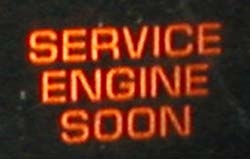
A check engine light (CEL), also called a malfunction-indicator light (MIL) is a warning sign that something within your engine, fuel or emissions system is not operating correctly. While most check engine lights do not point to dire problems that would cause your vehicle to break down, some do. Check engine lights are usually an indicator of an emission-related problem. Check engine lights can cause your vehicle to perform inefficiently and fail an emissions test.
Tighten your gas cap (three clicks) and continue to drive your vehicle. One of the most common reasons for a check engine light is a loose gas cap. A loose gas cap can trigger several emission-related codes to your vehicle's diagnostic system. If the check engine light does not turn off after 15 to 20 minutes of driving, begin diagnosing the problem.

Turn your ignition to the "On" or "Acc" position, without cranking the engine. Connect the OBD-II scanner to the diagnostic port in your vehicle. The diagnostic port is usually below the steering column in the area of the hood release.

Follow the specific scanner directions to retrieve the diagnostic codes. This is usually performed by pressing the "Scan" button on the device. Wait a few seconds for the scanner to list the codes. The scanner display will list the number of diagnostic codes. It is common for several codes to display. Write down each of them. Diagnostic codes are usually presented in five digits, such as "P0141."

Use the handbook supplied with your code scanner to determine the meaning of each code. For a more thorough listing, visit the website obd-codes.com. This website will give you a complete listing of OBD-II codes, as well as their possible causes. Some code meanings will be very direct and clear, such as "O2 sensor failure" or "Catalytic Converter." Others will be broad in their possible causes.

Determine whether you can fix the problem on your own. Some simple problems, such as an engine misfire on cylinder 1, will lead to simple problems such as a faulty spark plug or wire. These problems can usually be tackled at home by the mechanically inclined.
Bring the vehicle to a service shop if the problem cannot be solved at home. By diagnosing the problem on your own, you may save yourself a mechanic's diagnostic fee (usually $75 or $100).